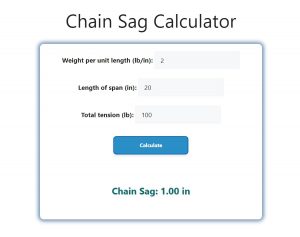About Chain Sag Calculator (Formula)
The Chain Sag Calculator is a practical tool for engineers, riggers, and anyone involved in lifting operations. It helps determine how much a chain will sag under its own weight and the tension applied to it. Understanding chain sag is crucial in various applications, such as rigging for theatrical performances, construction, and transportation, to ensure safety and efficiency. By calculating the sag, users can make informed decisions about load limits, installation heights, and overall safety measures.
Formula
The formula for calculating the chain sag is:
S = w * l² / (8 * T)
Where:
- S = sag (in units of length, e.g., inches or meters)
- w = weight of the chain per unit length (in weight units, e.g., pounds or kilograms per meter)
- l = length of the chain (in units of length, e.g., inches or meters)
- T = tension applied to the chain (in weight units, e.g., pounds or kilograms)
How to Use
Using the Chain Sag Calculator involves the following steps:
- Gather Required Information: Measure the length of the chain (l), determine the weight of the chain per unit length (w), and know the applied tension (T).
- Input Values: Enter the values for weight (w), length (l), and tension (T) into the calculator.
- Calculate Sag: Use the formula to compute the sag (S). The calculator will apply the formula and display the result.
- Analyze the Results: Review the calculated sag to assess if it meets safety and operational requirements.
Example
Let’s consider a practical example for better understanding:
- Weight of Chain (w): 2 pounds per foot
- Length of Chain (l): 20 feet
- Tension (T): 100 pounds
Using the formula:
S = (2 * 20²) / (8 * 100)
S = (2 * 400) / 800
S = 800 / 800
S = 1 foot
In this example, the sag of the chain is 1 foot, indicating how much the chain will dip under the given tension and weight.

FAQs
- What is chain sag?
- Chain sag refers to the downward curvature that occurs when a chain is loaded and tension is applied, causing it to droop.
- Why is it important to calculate chain sag?
- Calculating chain sag is crucial for ensuring safety and proper functioning in lifting applications, preventing equipment failure and accidents.
- What units can be used for measurements?
- Measurements can be taken in various units, such as pounds, kilograms, feet, or meters, but be consistent within the calculation.
- How does the length of the chain affect sag?
- Longer chains generally experience more sag due to the greater distance over which the weight can act.
- What factors influence chain sag?
- Factors include the weight of the chain, the length of the chain, and the tension applied to it.
- Can this calculator be used for other types of cables?
- Yes, the principles of sag calculation can also apply to other types of cables and ropes under similar conditions.
- How can I reduce chain sag?
- Reducing the length of the chain or increasing the tension can help minimize sag.
- What is the maximum allowable sag for safety?
- The maximum allowable sag varies by application and safety standards; consult relevant guidelines for specifics.
- How does chain material affect sag?
- Different materials have different weights, affecting the sag based on the same length and tension.
- Is there a specific tension that should be used for calculations?
- The tension should be based on the load being lifted; exceeding the safe working load can lead to dangerous conditions.
- What happens if I ignore chain sag?
- Ignoring chain sag can lead to improper load placement, potential equipment failure, and safety hazards.
- How do I determine the weight of the chain per unit length?
- The weight per unit length can usually be found in the manufacturer’s specifications or by weighing a known length of the chain.
- Can sag affect the alignment of equipment?
- Yes, excessive sag can misalign equipment, causing operational issues and potential damage.
- What tools do I need for this calculation?
- You need a measuring tape, a scale (to measure the chain’s weight), and a calculator for the formula.
- Is there an industry standard for acceptable sag?
- Industry standards vary; check local regulations and best practices for specific sag allowances.
- How does temperature affect chain sag?
- Extreme temperatures can affect the chain’s material properties, potentially altering its weight and flexibility.
- What if I have multiple chains connected?
- Each chain may need to be evaluated individually for sag, considering the combined load on each.
- Can sag be calculated for non-linear applications?
- Sag calculations are primarily linear; for complex systems, consult engineering guidelines or professionals.
- How do I measure the length of the chain accurately?
- Use a tape measure to ensure accurate measurement, accounting for any additional lengths from fittings or attachments.
- When should I recalculate chain sag?
- Recalculate whenever there are changes in load, chain length, or tension settings.
Conclusion
The Chain Sag Calculator is a valuable tool for ensuring safe and effective lifting operations. By using the formula S = w * l² / (8 * T), users can easily determine how much sag will occur based on the weight of the chain, its length, and the tension applied. This understanding is vital for anyone involved in rigging, construction, or heavy lifting, helping to prevent accidents and equipment failure. Regular calculations and adherence to safety guidelines can significantly enhance operational safety and efficiency.